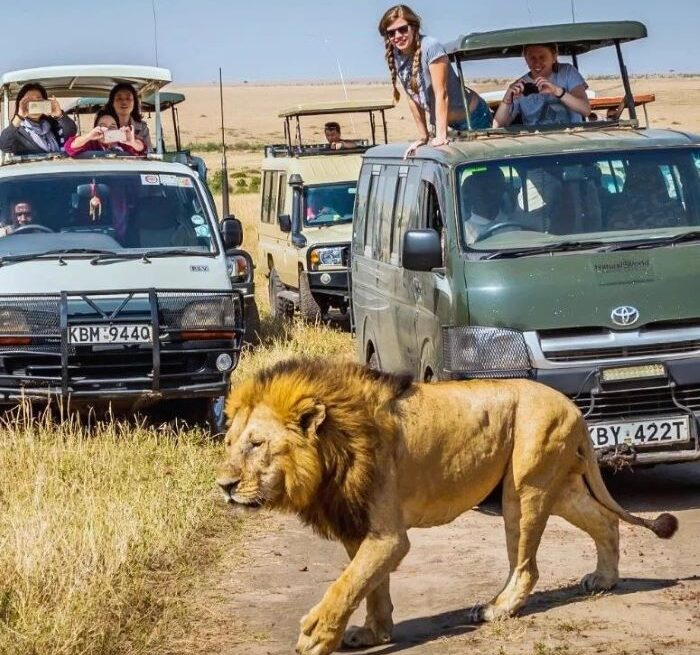The Great Migration is often referred to as one of nature’s most awe-inspiring spectacles. Every year, over 1.5 million wildebeests, zebras, and gazelles make their epic journey across the plains of the Serengeti in Tanzania and the Maasai Mara in Kenya. This incredible movement is driven by the search for fresh grazing, and along the way, the animals face the daunting challenges of river crossings, predators, and harsh weather. For nature lovers and safari enthusiasts, witnessing the Great Migration is a once-in-a-lifetime experience, and Kenya is one of the best places to see it in full force.
In this guide, we’ll dive into when and where to witness the Great Migration in Kenya, specifically in the famous Maasai Mara, along with insider tips to make the most of your trip.
What Is the Great Migration?
The Great Migration refers to the annual movement of over 1.5 million wildebeests, along with hundreds of thousands of zebras and gazelles, as they travel in search of greener pastures. This mass migration is driven by the changing seasons and the availability of fresh grazing and water. The migration is not a simple back-and-forth journey, but rather a complex, circular route that follows a seasonal pattern between the Serengeti National Park in Tanzania and the Maasai Mara National Reserve in Kenya.
The journey is fraught with danger. Along the way, the herds must cross treacherous rivers like the Grumeti River and Mara River, where crocodiles and predators lie in wait. Despite the perils, the Great Migration is one of the most sought-after wildlife experiences in the world.
The Best Time to Witness the Great Migration in Kenya
The timing of the Great Migration is essential for planning your safari. The animals move in a seasonal pattern, which can vary slightly from year to year based on weather conditions and food availability, but there are certain times of the year when you’re most likely to witness the migration at its peak in Kenya’s Maasai Mara.
1. The Arrival in Maasai Mara: July to October
While the migration technically begins in the Serengeti in Tanzania, the real drama unfolds when the herds begin to move into the Maasai Mara. The best time to witness the Great Migration in the Maasai Mara is from July to October. During these months, the wildebeests and zebras arrive in the Mara’s vast plains, following the rain patterns and seeking out fresh grazing. This period also marks the most intense phase of the migration, as the herds cross the Mara River, where predators lie in ambush.
- Peak Migration Time: Late July to early October.
- What to Expect: This is the most dramatic part of the migration, as herds begin to cross the Mara River in search of better grazing. Expect to witness thrilling river crossings, as the animals battle crocodiles and navigate dangerous currents. The predators—lions, cheetahs, and hyenas—are on high alert, making for some intense wildlife action.
2. The River Crossings: July to September
One of the most iconic moments of the Great Migration is the Mara River crossing, which occurs between July and September. The river is the final obstacle the animals must face before they reach the lush grazing grounds of the Maasai Mara. The sight of thousands of wildebeests, zebras, and gazelles charging into the river, with crocodiles lurking beneath the water’s surface, is a dramatic and thrilling experience. This is a photographer’s dream and a highlight of any safari.
- Best for River Crossings: Late July to September.
- What to Expect: You’ll witness the dramatic spectacle of the herds assembling at the riverbanks, and possibly see them attempt multiple crossings. Some crossings are peaceful, while others can turn into chaotic and violent struggles as the animals try to avoid crocodile attacks and navigate the swift currents.
3. The End of the Migration: October to November
After the animals have crossed the Mara River and grazed the Mara’s fertile plains, they begin to head back towards the Serengeti in Tanzania, typically around October. By this time, the plains of the Maasai Mara start to dry up, and the herds move southward in search of fresh food and water.
- Best Time for Quiet Safari: October and November, after the main migration has passed.
- What to Expect: While the huge herds have moved on, this is still an excellent time to witness the aftermath of the migration, with predator-prey interactions still ongoing. It’s also a quieter time to visit, as fewer tourists are around, and you may have more exclusive sightings.
Where to Witness the Great Migration in Kenya
While the Maasai Mara is the primary destination for viewing the Great Migration, there are other areas that offer prime safari experiences during this period.
1. Maasai Mara National Reserve
The Maasai Mara is arguably the best place in Kenya to experience the Great Migration, especially between July and October. This expansive reserve offers luxury safari camps, game drives, and hot air balloon safaris, giving you multiple ways to witness the migration.
- Best Areas for Viewing: The Mara River is the prime location for river crossings, but the Mara Triangle and Talek River also offer excellent opportunities to spot herds of wildebeests and zebras grazing on the plains.
2. Mara Conservancies
In addition to the main Maasai Mara Reserve, there are several private conservancies that offer exclusive safari experiences with fewer tourists. These areas are especially beneficial for those seeking a more intimate experience with wildlife.
- Top Conservancies: Olare Motorogi Conservancy, Mara North Conservancy, and Naboisho Conservancy. These areas allow for night drives, walking safaris, and more personalized wildlife experiences, making them a great choice for those who want to escape the crowds and see the migration up close.
3. Kenya’s Other Wildlife Reserves: Tsavo & Amboseli
While the Maasai Mara is the prime location for witnessing the Great Migration, Tsavo National Park and Amboseli National Park also provide excellent wildlife viewing during the migration period. However, the migration itself doesn’t pass through these parks. Instead, you can enjoy sightings of resident wildlife, including elephants in Amboseli and lions in Tsavo, without the crowds typically associated with the Mara.
- Tsavo: Known for its vast landscapes and famous red elephants, Tsavo offers a unique safari experience during the migration months, though it is not a key location for the migration itself.
- Amboseli: Famous for its Mount Kilimanjaro views and large elephant herds, Amboseli offers a tranquil safari experience, and while you won’t see the migration here, it’s still worth visiting for the incredible wildlife.
Insider Tips for Witnessing the Great Migration
- Book Early: The Great Migration is a major draw for tourists, so accommodations and safari tours can fill up quickly, especially in the Mara. It’s best to book well in advance to secure your spot in luxury lodges or camps during peak migration periods.
- Opt for a Private Safari: To avoid the crowds and have a more personalized experience, consider booking a private safari or staying in one of the many private conservancies around the Maasai Mara. This ensures you have access to less-visited areas and more exclusive game viewing.
- Pack for Photography: The Great Migration is a photographer’s dream, so make sure you bring a good camera with a telephoto lens. The river crossings and predator interactions provide incredible action shots.
- Be Prepared for Long Days: Safari game drives in the Mara can be long and bumpy, especially during the migration period. Early mornings and late evenings are the best times for wildlife sightings, so be ready to start your day early to catch the migration at its most active.
- Take a Hot Air Balloon Ride: For a unique perspective of the migration, consider taking a hot air balloon safari over the Mara. Floating above the herds gives you an aerial view of the vast landscapes and herds moving below.
Witnessing the Greatest Show on Earth
The Great Migration is one of nature’s most dramatic and awe-inspiring events, and Kenya offers some of the best vantage points to witness it in all its glory. From the thrilling Mara River crossings to the endless plains filled with wildebeests and zebras, the Maasai Mara provides an unforgettable safari experience.
Whether you choose to visit between July and October to catch the migration at its peak or take advantage of quieter months like November, you are guaranteed a wildlife adventure like no other. So pack your camera, book your trip, and get ready to experience one of the most incredible wildlife spectacles on Earth.
Start planning your Great Migration safari in Kenya today, and prepare to witness nature’s greatest wonder!




